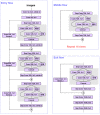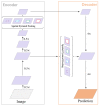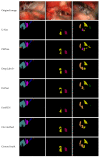Deep Neural Network-Based Semantic Segmentation of Microvascular Decompression Images
- PMID: 33562275
- PMCID: PMC7915571
- DOI: 10.3390/s21041167
Deep Neural Network-Based Semantic Segmentation of Microvascular Decompression Images
Abstract
Image semantic segmentation has been applied more and more widely in the fields of satellite remote sensing, medical treatment, intelligent transportation, and virtual reality. However, in the medical field, the study of cerebral vessel and cranial nerve segmentation based on true-color medical images is in urgent need and has good research and development prospects. We have extended the current state-of-the-art semantic-segmentation network DeepLabv3+ and used it as the basic framework. First, the feature distillation block (FDB) was introduced into the encoder structure to refine the extracted features. In addition, the atrous spatial pyramid pooling (ASPP) module was added to the decoder structure to enhance the retention of feature and boundary information. The proposed model was trained by fine tuning and optimizing the relevant parameters. Experimental results show that the encoder structure has better performance in feature refinement processing, improving target boundary segmentation precision, and retaining more feature information. Our method has a segmentation accuracy of 75.73%, which is 3% better than DeepLabv3+.
Keywords: DeepLabv3+; decoder structure; encoder structure; microvascular decompression image; semantic segmentation.
Conflict of interest statement
The authors declare no conflict of interest.
Figures










Similar articles
-
Multi-Scale Deep Neural Network Based on Dilated Convolution for Spacecraft Image Segmentation.Sensors (Basel). 2022 Jun 1;22(11):4222. doi: 10.3390/s22114222. Sensors (Basel). 2022. PMID: 35684842 Free PMC article.
-
Research on Ground Object Classification Method of High Resolution Remote-Sensing Images Based on Improved DeeplabV3.Sensors (Basel). 2022 Oct 2;22(19):7477. doi: 10.3390/s22197477. Sensors (Basel). 2022. PMID: 36236574 Free PMC article.
-
A multiple-channel and atrous convolution network for ultrasound image segmentation.Med Phys. 2020 Dec;47(12):6270-6285. doi: 10.1002/mp.14512. Epub 2020 Oct 18. Med Phys. 2020. PMID: 33007105
-
The Progress of Medical Image Semantic Segmentation Methods for Application in COVID-19 Detection.Comput Intell Neurosci. 2021 Nov 22;2021:7265644. doi: 10.1155/2021/7265644. eCollection 2021. Comput Intell Neurosci. 2021. PMID: 34840563 Free PMC article. Review.
-
[Application of semantic segmentation based on convolutional neural network in medical images].Sheng Wu Yi Xue Gong Cheng Xue Za Zhi. 2020 Jun 25;37(3):533-540. doi: 10.7507/1001-5515.201906067. Sheng Wu Yi Xue Gong Cheng Xue Za Zhi. 2020. PMID: 32597097 Free PMC article. Review. Chinese.
Cited by
-
Intraoperative tissue classification methods in orthopedic and neurological surgeries: A systematic review.Front Surg. 2022 Aug 3;9:952539. doi: 10.3389/fsurg.2022.952539. eCollection 2022. Front Surg. 2022. PMID: 35990097 Free PMC article. Review.
-
Multi-Scale Deep Neural Network Based on Dilated Convolution for Spacecraft Image Segmentation.Sensors (Basel). 2022 Jun 1;22(11):4222. doi: 10.3390/s22114222. Sensors (Basel). 2022. PMID: 35684842 Free PMC article.
-
PlaqueNet: deep learning enabled coronary artery plaque segmentation from coronary computed tomography angiography.Vis Comput Ind Biomed Art. 2024 Mar 22;7(1):6. doi: 10.1186/s42492-024-00157-8. Vis Comput Ind Biomed Art. 2024. PMID: 38514491 Free PMC article.
-
Automated Extraction of Phenotypic Leaf Traits of Individual Intact Herbarium Leaves from Herbarium Specimen Images Using Deep Learning Based Semantic Segmentation.Sensors (Basel). 2021 Jul 2;21(13):4549. doi: 10.3390/s21134549. Sensors (Basel). 2021. PMID: 34283110 Free PMC article.
References
-
- Li Q., Cai W., Wang X., Zhou Y., Feng D.D., Chen M. Medical image classification with convolutional neural network; Proceedings of the 2014 13th International Conference on Control Automation Robotics & Vision (ICARCV); Singapore. 10–12 December 2014; pp. 844–848.
MeSH terms
LinkOut - more resources
Full Text Sources
Other Literature Sources

